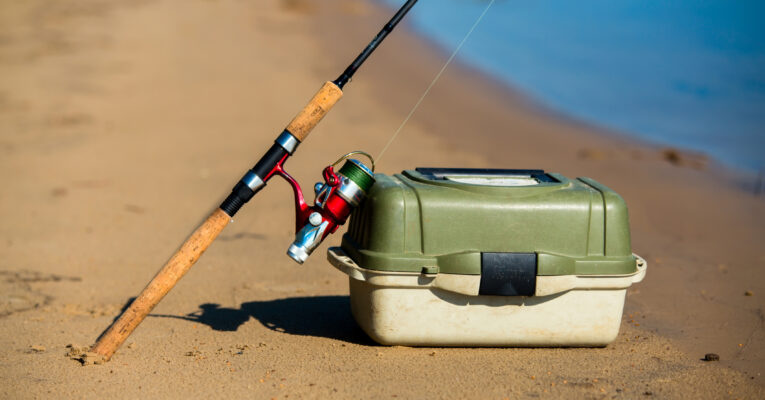When it comes to fishing, success often comes down to preparation. A well-equipped fly fishing tackle box can significantly improve your experience, increasing your chances of a successful catch. Whether you’re a seasoned angler or a novice testing the waters, you’ll find this comprehensive freshwater tackle box checklist invaluable. Here are the essentials for setting up a tackle box for fishing that will make your next trip to The Franklin Club, or any body of water, a joy.
1. Extra Fishing Line
No fishing trip can begin without a dependable fishing line. This indispensable item forms the connection between you and your catch, and different fishing conditions and species necessitate varying types of lines.
Always have a robust, heavier line for those situations where large, aggressive fish are your target and lighter lines for the calm waters where you’re pursuing smaller, more timid species. Also, having a spare line comes in handy when your main line snaps, gets tangled or gets caught on a snag. It saves you the time and frustration of cutting your trip short.
2. A Variety of Hook Sizes
As diverse as the fish in the sea (or river, or lake) are the hook sizes that you should pack in your tackle box. Every species of fish responds to a different size of hook; hence having an assortment allows you to cast your line, confident that whatever fish is in those waters, you have the right hook to catch it. Our comprehensive guide on how to choose the right fly fishing hook size offers in-depth insights on what to consider when making your selection.
3. A Multitool
Imagine having a knife, a pair of scissors, and a set of pliers all compacted into one handy device. That’s what a multitool offers. With this tool, you can cut lines, shape baits, remove hooks securely, and handle a myriad of tasks that would otherwise require an entire toolbox. It’s a must-have for any angler who values convenience and efficiency.
4. Tape Measure
Whether you’re tracking your personal bests or ensuring your catch meets the legal size limits, a tape measure is crucial. This simple tool will help you maintain a log of your catches while ensuring that your fishing adventure is in line with the local regulations. Remember, ethical fishing is a responsibility that falls on every angler’s shoulders.
Stay up to date on Ontario’s fishing regulations here.
5. Swivels and Snaps
Prevent your line from twisting and turning when the fish decides to put up a fight with the help of swivels and snaps. These small devices also allow you to change hooks or lures easily without cutting and re-tying your line, saving you precious time during your fishing trip.
6. Bobbers and Floats
Keenly watching your bobbers and floats as they buoy on the water’s surface can be the most exciting part of fishing. These devices alert you when a fish bites or takes your bait by dipping or moving in a particular pattern. Especially for beginners, they make detecting bites much more manageable until you learn to feel the bite via the line itself.
7. Sinkers and Weights
Your bait needs to reach the depth at which the fish are swimming, and this is made possible by sinkers and weights. By attaching these to your line, your bait descends faster and stays in the desired depth zone, increasing your chances of catching fish. Remember, it’s common to lose sinkers during fishing trips, so keep plenty of extras in your tackle box just in case.
8. Lures, Flies or Bait
As we all know, it takes the right bait to catch the fish. This is where lures, flies, or bait come into play. The type of fish you’re looking to catch and how you’re fishing will dictate the kind of bait you use. Be sure to read up on local regulations or ask our club pros for guidance.
9. Bite Indicators
Bite indicators are an angler’s best friend, giving you a clear visual signal when a fish is biting your bait. These devices come in a variety of styles, from simple bobbers to high-tech electronic indicators.
10. Bug Spray
Fishing trips often take you into the great outdoors, where bugs and mosquitoes can be a nuisance. Pack a reliable bug spray to keep your fishing experience comfortable and itch-free.
11. First Aid Kit
Safety should always be a priority when fishing. A first-aid kit in your tackle box ensures you’re prepared to handle any minor injuries. This should include bandages, antiseptic wipes, tweezers for any rogue hooks, and medical tape.
12. Sun Protection
Fishing often means long hours under the sun. Pack broad-spectrum sunscreen, sunglasses, and a hat in your tackle box to protect yourself from harmful UV rays.
Before you head out onto the water, be sure to check out our blog on the top 5 trout fishing gear essentials!
Test Out Your Newly Packed Fishing Tackle Box at The Franklin Club
With your tackle box now brimming with all these essentials, it’s time to put it to the test. There’s no better place than The Franklin Club, a members-only oasis for fishing enthusiasts with its natural beauty and abundant trout population.
Our club offers a range of membership benefits and privileges that you’ll definitely want to explore. Contact us today to learn more about becoming a Franklin Club member!
In fishing, as in life, the key to success is preparation. With a well-packed tackle box, you’ll be ready for whatever your fishing adventures throw your way. Here’s to a great day of fishing and a bountiful catch. Tight lines!


